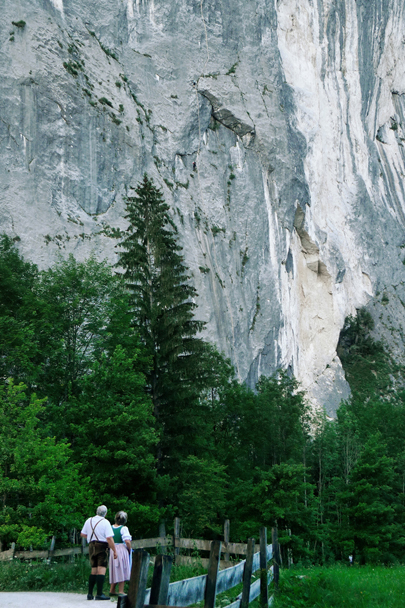 |
|
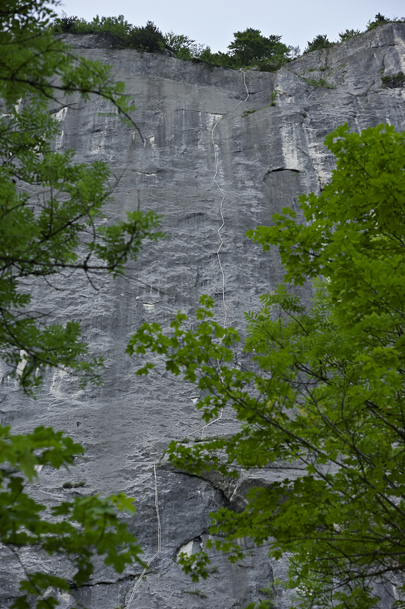 |
|
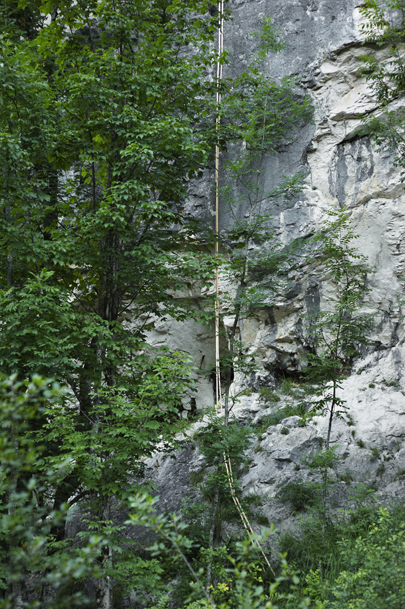 |
|
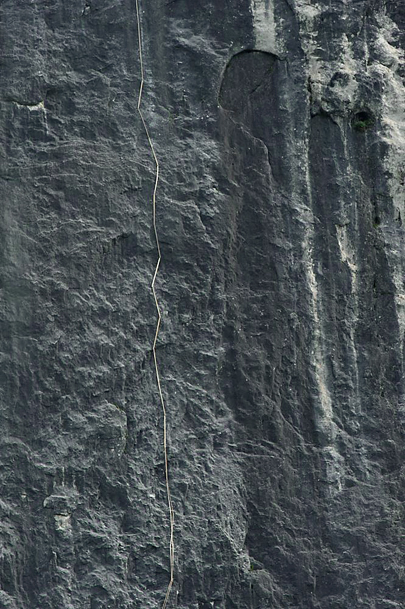 |
|
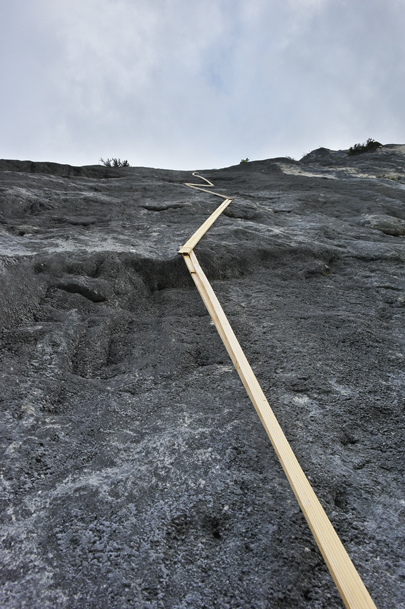 |
|
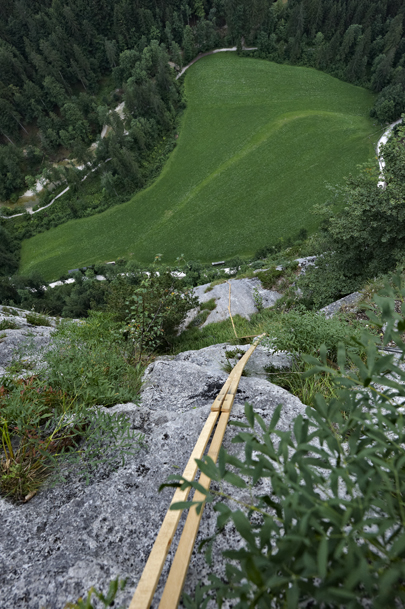 |
|
|
|
 |
|
 |
|
 |
|
 |
|
 |
|
 |
|
|
|
Ever since the emergence of Land Art in the 1960s, landscape has been a prominent
topic in contemporary art. Whether for its existential materiality or its aesthetic
emanation, its archaic dimension or an ecological hazard, its shared human affinity or as a cultural transformation, landscape has become a place of complex and multi-layered artistic reflections, beyond impressionistic and expressionistic modes of perception.
Going far beyond classical Land Art, Daniel Zimmermann perceives landscape not only as a temporal but, above all, a medial 'event perception'. The focus is always on the relationship of landscape and picture. Landscape is probed and made tangible as an event of sight. It is about the potentials of the figurative, which are to be made virulent. For more than two decades, the artist has been accompanied by unwrought wooden slats of 8.86 feet in length that represent a conceptual constant in his installations. Whether in the context of the 'Mondsee Land Art' projects, his work at the St. Moritz bobsleigh run, the route of the Lauberhorn Downhill in Wengen / Switzerland, or with his current film project Stick Climbing, the wooden slats are a recurring visual trace in his involvement with nature and its cultural and social appropriation.
A challenging climbing route in a small Austrian mountain village is the visual set for
Daniel Zimmermann's most recent work of research into landscape. The beginning of the film establishes an expansive scenery; a walk through the village already sets the stage for his explorations. The camera pans through the village, showing its early morning activities, framing the visual experience atmospherically. This overture is an extension of his former conceptual works with landscape and it explicitly features the area of tension that exists between of the real and the staged. From the outset, the camera's perspective is transformed into a radically subjective view and as an objective rapprochement of the actual event; this abruptly suspends the distance between the observer and the observed while heaving the observer into the position of the person experiencing the climb.
The wooden slats installed along the climbing route function as an interface between
nature and culture, between the real rock face and the involved climber and beholder. They are the conceptual hub of Daniel Zimmermann's landscape projects: pure nature with respect to the materiality of the wooden slats, nature transformed with respect to their semiotic capacity. It is on them that the gaze focuses and they conflate nature and its representation as an artistic symbiosis. While it is photography that, since the 19th century, ubiquitously turns landscape into representational pictures, the conceptual procedure achieves to transform images of landscape again into the landscapes themselves. The artificiality of this procedure allows for a new approach to conceptualizing landscape.
By way of this usage of the cinematic principle of time lapse, the beholder may climb
virtually along the route of the rock face as laid out with the wooden slats. Far beyond the marking of landscape, it is the art of the route's layout, which so significantly characterises the landscape work of the artist. Over years now, Zimmermann has consequently probed and unfolded terrains of the figurative and visual, staging temporary interventions in original landscapes. With Stick Climbing as an on-the-spot event and a cinematic-medial transposition, he achieves the interconnection of nature and culture through the form of a parallel discourse. Thus, the panoramic end of the film simultaneously imagines the cultural sovereignty of the gaze over the event and the majestic sovereignty of nature.
The polyperspectival and the polymedial are essential parameters of Daniel
Zimmermann's artistic self-conception. Through his oscillating between working with
various media and his activist operations, one can grasp the process-oriented
understanding of Zimmermann's work that firmly characterises all of his projects. Thus, in climbing up the rock face, the artist's conquering exploits of the gaze as a way of constituting the world and its image is rendered as metaphor.
Carl Aigner
Direktor des Niederösterreichischen Landesmuseums St. Pölten Gründungsheraus-geber der Kunstzeitschrift für Photographie & Neue Medien EIKON, Wien Präsident von ICOM-Österreich (Internationaler Museumsrat)
Performing the landscape
On Daniel Zimmermann's project 'Stick Climbing'
Amanda Piña
This time it is happening on a 721.8-foot high vertical rock face towering above Lake Grundl in the district of Liezen, Styria, Austria. Daniel Zimmermann's most recent installation marks a difficult if not altogether impossible climbing route laid out with two hundred wooden slats.
In his new project that consists of an installation, a short film, and 3D photographs –
everything subsumed under the title Stick Climbing, Zimmermann again makes the landscape perform.
The installationThe term sublime (derived from the Latin sublimis meaning "uplifted, high, lofty"), particularly refers to a greatness that can not be compared with anything else and that is beyond all possibility of calculation, measurement or imitation. Contrary to its expression in romantic art, Zimmermann's sublime is abstract, devoid of the pathos of interpretation or any trace of selfexpression.
Its 'ecology' lies in exposing or framing the expressivity of nature itself. The elements, stone masses, the forest, and the mountain, are among the favourite topics of romantic depictions of the sublime. Using his work material, 8.86ft wooden slats as vectors of direction or traces of movement, Zimmermann draws a nearly straight line up on the rock face, which towers over a little village, an idyllic landscape and a lake.
The idea of climbing the rock transforms our view into a wildly threatening sight. The obvious difficulty of the task of fixing the wooden sticks to the rock and the apparent lack of practicality of it makes us look up; and we are left wondering, gawking with mouths open: Why? And, Who the hell would have thought such a crazy idea?
The installation challenges the perception of the viewer, as the mind is inept at organizing the world rationally all the time. Or, as Lyotard says:
What happens in the sublime is a crisis where we realize the inadequacy of the
imagination and reason. What we are witnessing, is actually the Differend; the
straining of the mind at the edges of itself and at the edges of its conceptuality.
The installation will run for two months. By chance, locals, climbers, as well as tourists may discover and explore Stick Climbing while they too look up from below. Also wondering "why?", "how?", and "who?"
The film In most of Zimmermann's works the relationship between subject and object is questioned or even inverted. For instance, in his 3D-viewer installations, the beholder becomes part of the work. In order to be able to see through the 3D-viewer, the beholders must involve themselves physically with the activity of seeing the work - sometimes on their knees, lying down on a carpet, etc.; thus, integrating their bodies into the art work. In Zimmermann's films it is the viewer as beholder who becomes the performer, the climber in this film.
With Stick Climbing, filmed from the perspective of the climber, we are witnesses of the cinematic space in a very special way. One becomes an individual viewer who walks through the village and climbs up the rock face; and, identifying with the gaze of the camera, we walk through the village, meeting other people on our way, leaving people behind to immerse ourselves in the wilderness, and, finally climbing up the rock all the way to the top.
In order to watch the film, one must become a subject that experiences space in performance. We experience the landscape - in this case, a large rock face - from the perspective of the climber who performs the difficult task of ascending up the route marked by wooden slats. With Stick Climbing, our gaze is transformed into the gaze of a climber and in a way that, previously, we could perhaps only imagine; we climb up the rock along the two parallel lines of wooden slats without any effort at all.
Difficult tasks, virtuality, and embodiment When looking at the installation Stick Climbing, we might keep pondering to ourselves: What is this? Who came up with it? What is the idea behind this? To fix wooden slats on this rock must be hard. How has this been accomplished? With ropes and climbers? Did they start from below or from above?
There is a sense of virtuosity in accomplishing this task even if we ignore its purpose or how it was achieved. It is something that seems almost impossible to be done, both to imagine and to realize.
The virtuosity of the installation can be compared with a tour en l'air of a dancer; something hard to do that seems to be devoid of any practical purpose, but is pure motion and grace.
When we see a dancer performing a tour an l'air we can easily identify with such physicality. As the latest research on mirror neurons indicates, while observing another person moving, we 'identify' physiologically with the movements performed. In our brain, the same areas are activated as in the brain of the person moving; we move without actually moving ourselves physically. This is the principle of mimesis and this is how we learn as infants, to do what grown-ups do, by way of imitating them.
In virtual realities and certain computer games, this happens in an even more radical way: the gamer moves within the virtual environment but does not see him- or herself. The body and senses of the players are activated and, through their gazes, transferred into so-called virtual reality. The players can experience movement through the representational movement of what they see - a virtual embodiment of space by way of creating a virtual visual field within which we move as if it would be our body moving in that space. This type of virtual movement experience is exactly what Daniel Zimmermann explores in his film.
In the case of Zimmermann's work we would not find any special effects but rather a highly sensitive use of the camera, of sound, landscape, and wooden slats – his work material. The effort of climbing up the rock face is transferred into the body of the observer; and, through this virtually active body, the identification happens in a very particular way. When watching the film, we identify ourselves with an action and not with a person. Since we do not see somebody to identify with, we directly become the virtual subject that is performing the action. Our body is influenced by its efforts, and the frequency of our breath is altered. It is not so important what we see – in this case, the village, the forest, the rock face and the wooden slats – but how we experience all this counts here.
Stick Climbing is a highly performative film work that, first of all, conveys an experience itself and not its interpretation by a character or an actor. All of the people in the film are 'secondary actors' and, in this sense, one could state that the main protagonist of the film is the landscape itself, which is given most 'screen time' during the short film's 12 minutes. However, it might be even more accurate to say that it is the camera and, through its gaze, the spectator, who plays the main role in this film. Thus, Stick Climbing is not a group activity; as an individual, one must leave the village behind in order to practice and experience it..
Amanda Piña
Choreografin, Regisseurin und Performerin, Gründungsmitglied der Performance Kompanie nadaproductions, Wien
Role-play in spatial extremes
Robert Buchschwenter
The sublime is a matter of impression.
Whether a natural wonder appears to be more sublime than a simple building is not
dependent on the thing itself but rather on the position of the beholder.
Seen through a camera, the sublime may be banal or the banal sublime, the unreachable near or the near inaccessible.
Through the position of the camera, the role of the beholder is defined according to the presumed accessability or inaccessability of things arranged in cinematic space.
The dramatic impulse in Stick Climbing occurs with the attempt to touch things. Its
measure is defined by the quality of cinematic space, its weight by the consistency of the 'beholder's share'.
Corner marks and base linesStick Climbing starts with a brief intro, where Daniel Zimmermann defines the coordinates of his cinematic space. The vertical is this system's main parameter. Slowly the camera pans from the tip of the shingle-covered church tower down to the street, where it stops briefly to draw attention to a small group of people standing in front of the church. It is not only the tower that dominates this seemingly unspectacular event, but also a massive rock formation that appears only for a few moments; at this point, due to the permanent movement of the camera, the beholder's gaze slides down and simultaneously off the rock face. Speaking in terms of a tentatively established narrative and action space, the scantly one-and-a-half-minute exposition presents the beholder with a shifting perspectives that is remarkably ambivalent: a church tower that prominently flanks the scenario and yet fragmentary, the massive rock face that appears to fill the picture, a conversation consisting of unintelligible tatters of dialogue blown away by atmospheric sounds, a dominant environment that gives but a vague impression
of village life. However, an aforementioned principle of form is established unmistakingly: the vertical movement.
In this way, the introductory footage of Stick Climbing essentially achieves nothing less than what marks the beginning of full-blown film dramas: the allusion formally directed to an event that is enough to work as a frame, but that reveals little enough to expand into a spatial tension. But, rather than destroying this space by way of explicit turns, Daniel Zimmermann creeps up on the plot rather consequently; he does so by means of a subtly reserved connection with an already established scenic and formal setting. The camera's forward movement is cautiously executed to reveal a sketch of the village that unfolds into the scenario that firstly expands the formally dominant perpendicular, which is achieved by adding a horizontal dimension; that thereby completes the scenic space without rendering it obvious. It is the beholder who is surrounded by space rather than vice versa – similar to those atmospheric spaces that permeate the wanderer while his or her gaze scans the ephemeral moments of its surfaces.
Goal orientation and deviation As much as the camera's pans might seem to be self-absorbed and as ephemeral the movements of its gaze through the village may appear, they convey the underlying narrative movement with a soft emphasis, following a goal-oriented logic: on the one hand, there is the dramaturgic logic of a walk-about with an identifiable point of departure that therefore points tentatively towards an end; on the other hand, the formal logic of the choreography of the movements that starts with descending vertically and, after a brief excursion into the horizontal, presses towards a finale in a reverse ascent.
In fact, the contemplative movement along the horizontal ends exactly at the film's halftime, shifting to a perpendicluar, towering rock face to drastically continue vertically. In Stick Climbing, this moment marks not only the turning point of the arc of suspense now entering its precarious phase, but it also reveals the deeply comedic character of the 'drama'. Being confronted with the obvious unconquerable quality of this perpendicular rock face – namely the unsolvable conflict with gravity – one is surprised by the bizarre procedure implemented toward its solution: The route laid out with two rows of wooden slats next to or overlapping each other reveal themselves not only as a visual orientation, but turn out to be an absurdly efficient tool of ascent for the invisible climber, the beholder. The ascent thus takes on the comical tone of a joke that wraps the alluded dramatic process into an inappropriate turn.
This humoristic turn collides intentionally with another one that also, and above all,
appears to the audience as substantially dramatic. Until the moment of the ascent, one has adopted the perspective of the camera as one's own – an appropriately self-absorbed point of view that is not only disembodied but also lacks subjectivity. Yet, suddenly, the flesh of the invisible protagonist becomes tangible, a skin into which one has slipped in the face of the unconquerable rock. Accompanied by the increasingly heavy breathing (of the climber), the gaze itself (of the spectator) becomes tangible. The sense of fleetingness with which the gaze had encountered the various motifs has now given way to a haptic persistence. (The continuous take that is, for instance, in evidence while wandering through the village had the character of a light-footed observation; but, it now feels like a rigorously-tied fetter that anchors and steadies the gaze).
I (and I) The solution of the drama is again comedic insofar as the sensual experience gradually turns into a visceral physical experience and one begins to realise the lack of seriousness with which the camera performs in the role of the body. In other words, while we are trembling in the face of the almost tangible insuperability of the rock face, we also find ourselves in the grip of an electrifying marvel about the fact that we have been moving along the route at a gallop's pace. Daniel Zimmermann resolves this dramatic conflict in a way that recalls Sigmund Freud's definition of 'humour':
The grandeur in it clearly lies in the triumph of narcissism, the victorious assertion of the ego's invulnerability. The ego refuses to be distressed by the provocations of reality, to let itself be compelled to suffer. It insists that it cannot be affected by the traumas of the external world; it shows, in fact, that such traumas are no more than occasions for it to gain pleasure. [Sigmund Freud, Humour, International Journal of Psychoanalysis., 9 (1), 1-6., 1928]
As soon as we surrender to being guided by a cinematic agency, the narrative space
becomes real and the dramatic turns become the impulsive constituents of our second, cinematic 'I'. And, it is precisely to this 'I' that Stick Climbing appears as an exciting and, simultaneously, hilariously ambivalent experimental design: Buffeted between the challenge of playing along on the one hand and a humorous refusal of doing so on the other, it follows a perfectly drawn dramaturgic arc only to finally become aware that it has unfolded simultaneously in both roles enjoying the conflict as an added value. Having arrived at the end of the route, one looks one more time at the village deep below, at the bottom of the rock face as heavy breathing and distant sounds of a country festival fills one's ears. At this moment, the feeling of fatigue and the satisfaction of the climber is paired with the head-shaking disbelief and relief of its cinematic (alter) ego that has triumphed over the sublime.
Robert Buchschwenter
Drehbuchdramaturg und Filmproduzent, Lehrbeauftragter für Filmanalyse und Drehbuch, publizistische Tätigkeit für Print-, Radio- und TV-Medien